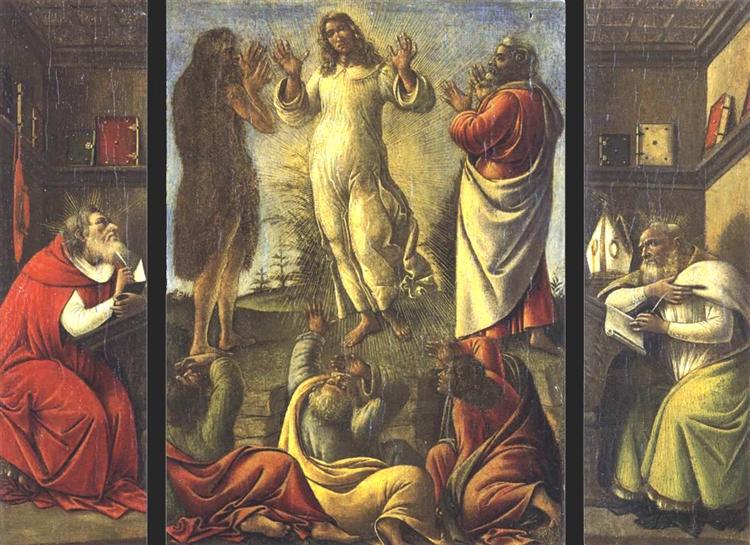תיאור
הציור "transfiguration - סן ג'רונימו - סן אגוסטין", שנוצר על ידי סנדרו בוטיצ'לי בשנת 1500, הוא יצירה המשקפת לא רק את השליטה הטכנית של האמן, אלא גם את הבנתו העמוקה של הרוחניות והפילוסופיה בהקשר של הרנסנס. בוטיצ'לי, אקספקטנט מצטיין של אמנות פלורנטין, מוכר ביכולתו להנחיל חיים ורגש בייצוגיו, המתבטא בבירור ביצירה זו.
הרכב הציור מאוזן להפליא וזהיר. במרכז, דמות ההשתנות של ישו נשברת באור שמימי, ומציעה מוקד חזק. סביבו מופצים דמויותיהם של סן ג'רונימו וסן אגוסטין, המיוצגות בתשומת לב רבה לפרטים הקטנים. סן ג'רונימו, משמאל, מוצגת בביטוי מהורהר, עם לבושו האופייני של קרדינל אדום, ואילו סן אגוסטין, מימין, מוצגת בהרגל הנזירי הייחודי שלה, מבטו המופנה לכיוון הצופה, כקריאה לקריאה לקריאה אליו הִשׁתַקְפוּת.
השימוש בצבע הוא משמעותי בציור זה. הברקה של גווני זהב וכחולים בבגדי הקדושים מנוגדים לרקע האפל ביותר, מה שמדגיש את הבולטות של דמויות העל. טיפול בצבעים משקף את התפתחותו של בוטיצ'לי לפלטה זוהרת, בניגוד ליצירותיו הקודמות, שם שלטו הניואנסים העדינים והנוראיים ביותר. בחירה זו של צבעים לא רק מספקת איכות חזותית מזעזעת, אלא יכולה להתפרש גם כסמליות של אור אלוהי שמאיר את הדמויות ובהרחבה, לצופה.
חשוב לציין כי לעבודה זו, בהקשר של זמנה, לא רק הייתה מטרה אסתטית, אלא גם ערך מסור משמעותי. ייצוג דמותו של ישו במצב של טרנספורמציה מעורר חוויה רוחנית אינטנסיבית, ומזמין התבוננות ומדיטציה עמוקה על הקשר בין האלוהי לאדם. בוטיצ'לי, שהושפע מחשיבה ניאו -פלטונית, מצליח לתפוס רעיון זה על ידי יצירת תחושה של גובה רוחני שמזמין את המתבונן להתעלות על החוויה הארצית.
היצירה, אף שהיא לא ידועה באופן אוניברסלי ככמה מציוריו של בוטיצ'לי, משקפת את התפתחותה כאמנית בשינוי המאה ומציגה את יכולתה לשנות את סגנוןיה. עם ההתמקדות שלו בדמויות מוגדרות היטב עם ביטויים רגשיים, בוטיצ'לי מתיישר עם החיפוש ברנסנס אחר הייצוג האנושי והדינמי ביותר של ענייני הדת.
באמצעות "transfiguration - סן ג'רונימו - סן אגוסטין", אנו לא יכולים רק להעריך את המיומנות הטכנית של בוטיצ'לי, אלא גם את הקשר שלה עם רוח הרנסנס, שם אמנות שימשה רכב של ביטוי אישי כמו דרך להעביר אמיתות רוחני עמוק. יצירה זו מאפשרת לנו להציץ לא רק רגע בהיסטוריה של האמנות, אלא גם באינטראקציה בין הקודש לחולץ, מאפיין מגדיר את יצירתו של בוטיצ'לי המהדהד גם בימינו.
KUADROS ©, צבע מפורסם על הקיר שלך.
ציורי שמן בעבודת יד, עם איכות אמנים מקצועיים וחותם ייחודי של KUADROS ©.
שירות רבייה בתמונות עם ערבות שביעות רצון. אם אינך מרוצה לחלוטין מהעתק הציור שלך, אנו מחזירים את הכסף שלך 100%.

